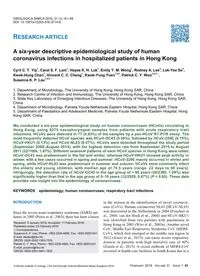
2016 A six-year descriptive epidemiological study of human coronavirus infections in hospitalized patients in Hong Kong PDF
Preview 2016 A six-year descriptive epidemiological study of human coronavirus infections in hospitalized patients in Hong Kong
VIROLOGICA SINICA 2016, 31 (1): 41–48 DOI: 10.1007/s12250-016-3714-8 RESEARCH ARTICLE A six-year descriptive epidemiological study of human coronavirus infections in hospitalized patients in Hong Kong Cyril C. Y. Yip 1, Carol S. F. Lam 1, Hayes K. H. Luk 1, Emily Y. M. Wong 1, Rodney A. Lee 4, Lok-Yee So 5, Kwok-Hung Chan 1, Vincent C. C. Cheng 1, Kwok-Yung Yuen 1,2,3, Patrick C. Y. Woo 1,2,3*, Susanna K. P. Lau 1,2,3* 1. Department of Microbiology, The University of Hong Kong, Hong Kong SAR, China 2. Research Centre of Infection and Immunology, The University of Hong Kong, Hong Kong SAR, China 3. State Key Laboratory of Emerging Infectious Diseases, The University of Hong Kong, Hong Kong SAR, China 4. Department of Microbiology, Pamela Youde Nethersole Eastern Hospital, Hong Kong SAR, China 5. Department of Paediatrics and Adolescent Medicine, Pamela Youde Nethersole Eastern Hospital, Hong Kong SAR, China We conducted a six-year epidemiological study on human coronaviruses (HCoVs) circulating in Hong Kong, using 8275 nasopharyngeal samples from patients with acute respiratory tract infections. HCoVs were detected in 77 (0.93%) of the samples by a pan-HCoV RT-PCR assay. The most frequently detected HCoV species was HCoV-OC43 (0.58%), followed by HCoV-229E (0.15%), HCoV-HKU1 (0.13%) and HCoV-NL63 (0.07%). HCoVs were detected throughout the study period (September 2008–August 2014), with the highest detection rate from September 2010 to August 2011 (22/1500, 1.47%). Different seasonal patterns of each HCoV species in Hong Kong were noted. HCoV-OC43 was predominant in the fall and winter, whereas HCoV-HKU1 showed peak activity in winter, with a few cases occurred in spring and summer. HCoV-229E mainly occurred in winter and spring, while HCoV-NL63 was predominant in summer and autumn. HCoVs most commonly infect the elderly and young children, with median age of 79.5 years (range, 22 days to 95 years). Intriguingly, the detection rate of HCoV-OC43 in the age group of > 80 years (26/2380, 1.09%) was significantly higher than that in the age group of 0–10 years (12/2529, 0.47%) (P < 0.05). These data provides new insight into the epidemiology of coronaviruses. KEYWORDS epidemiology; human coronaviruses; respiratory tract infections INTRODUCTION Since the severe acute respiratory syndrome (SARS) epi- demic in 2003 (Peiris et al., 2003), there has been a boost in the interest in the identification of novel coronavir- uses (CoVs). Human coronavirus NL63 (HCoV-NL63) was discovered in the Netherlands in 2004 (Fouchier et al., 2004; van der Hoek et al., 2004) and HCoV-HKU1 was identified from two patients with pneumonia in Hong Kong in 2005 (Woo et al., 2005a). Another novel CoV, Middle East Respiratory Syndrome CoV (MERS- CoV), which first emerged in the middle east region in 2012 (Assiri et al., 2013), can cause severe respiratory distress in patients with high mortality rate of 40% (Zumla et al., 2015). A recent outbreak of MERS-CoV occurred in health care facilities in South Korea due to a Received: 4 January 2016, Accepted: 11 February 2016, Published online: 23 February 2016 *Correspondence: Susanna K. P. Lau, Phone: +852-2255-4892, Fax: +852-28551241 E-mail:
